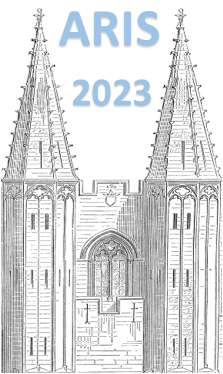Orateur
Description
Investigation of negative-parity band in $^{130}$Cs
C. Majumder$^{1}$, Pragya Das$^{1,*}$, H. K. Singh$^{1}$, U. Lamani$^{1}$, B. Bhujang$^{1,\#}$, and V. Pasi$^{1,\dagger}$
$^{1}$Department of Physics, Indian Institute of Technology Bombay, Mumbai, India.
$^{\#}$Present address: Govt. PU College, Shiggaon - 581205, Karnataka, India.
$^{\dagger}$Present address: Feat Educational Ventures Private Limited (Corporate Office) 201, Goregaon (W) - 400104, Mumbai, India.
$^{*}$pragya@phy.iitb.ac.in
Odd-odd Cs isotopes have been extensively studied by means of in-beam $\gamma$-ray spectroscopy, especially the positive-parity band based on $ \pi h_{11/2}\otimes\nu h_{11/2}$ for the chiral symmetry and signature inversion [1,2]. Our present study focuses on a negative-parity band based on $\pi h_{11/2}\otimes\nu g_{7/2}$ valence particle configuration in $^{130}$Cs [3]. We have studied the band structure by measuring lifetimes (in ps) of excited states using Doppler shift attenuation method (DSAM). Our new results on reduced transition probabilities (B(E2) and B(M1)) established the triaxial nature of the band consistent with the total Routhian surface (TRS) calculation.
We utilized the fusion-evaporation reaction $^{124}$Sn($^{11}$B, 5n)$^{130}$Cs to populate the high spin states of $^{130}$Cs. Energetic $^{11}$B beam at 70 MeV was delivered by the Pelletron accelerator facility at the Tata Institute of Fundamental Research, Mumbai, India. We utilized a self-supporting target ($^{124}$Sn) of thickness $\sim$ 2.2 mg/cm$^2$ sufficient to stop most of the recoiling nuclei. The emitted $ \gamma $-rays were detected by the 21 Compton suppressed HPGe Clover detectors of Indian National Gamma Array (INGA) [4]. The valid two- and higher-fold coincident $ \gamma $-events were recorded in list mode using PIXIE-16 based digital data acquisition system. The standard procedure of data analysis was adopted as described in our earlier work [5]. For the concerned negative-parity band, we first confirmed the decay scheme and spins up to 22 $\hbar$ by finding the Directional Correlation ratios. To extract the lifetimes, we fitted the DSAM lineshape profiles using the code LINESHAPE [6] for detectors located at angles of 23$ ^{0} $, 90$ ^{0} $, 157$ ^{0} $.
From our DSAM analysis, we determined the lifetimes of four states (14$^{-}$ to 20$^{-}$) within the range of 0.4 to 1.2 ps, with an average B(E2) value of 0.4 $e^2 b^2 $. There seems to be a slight decrease in B(E2) values with increasing spin. Interestingly, the band exhibits some striking features. Only the even spin states are populated above the bandhead 8$^{-}$, so the M1 transitions are missing. Above the backbend at around $\hbar\omega \simeq$ 0.38 MeV, both signature spins are observed with M1 transitions. However, the M1 is much weaker than the E2 transitions. The band shows the decoupling behaviour up to 16 $\hbar$, with energy spacings similar to the neighboring even-even and odd-even nuclei -- the ground state band of $^{128}$Xe [7] and $ \pi h_{11/2}$ band of $^{129}$Cs [5].
We performed the total Routhian surface (TRS) [8] calculation to study various features of the band. Firstly, we determined the deformation parameters values ($ \beta $, $ \gamma $) for the minimum energy configuration, from the contour plots for the band configuration $ \pi h_{11/2} \otimes \nu g_{7/2}$. In addition, we identified the first band-crossing for the neutron alignment in $h_{11/2}$ orbit from the quasi-particle Routhian diagram. The theoretical crossing frequency (0.40 MeV) was in agreement with the experimental observation. The proton alignment was ruled out because of the high values of the band-crossing frequencies for both positive and negative-parity orbits. Furthermore, we confirmed the neutron alignment by comparing the experimental B(M1) values with those obtained from the geometrical model of Donau and Frauendorf [9,10]. We extracted the experimental B(M1) values from the B(M1)/B(E2) ratios determined from the $\gamma$-ray intensity measurements, and B(E2) estimated from the DSAM analysis. Again, the proton alignment was ruled out by comparing the estimated and experimental B(M1) values.
In summary, we have investigated thoroughly the structure of the negative-parity band through lifetime measurement near and above the band-crossing region. A triaxial nuclear shape was inferred with deformation parameter values $ \beta $ = 0.16 and $ \gamma $ = $-30^{0}$ (in Lund convention) using the total Routhian surface calculation. We also established the neutron alignment with configuration $ \pi h_{11/2} \otimes \nu g_{7/2}(h_{11/2})^{2}$.
[1] E. Grodner $ et. al. $ Phys. Rev. Lett. 97, 172501 (2006).
[2] Y. Liu $ et. al. $ Phys. Rev. C 54, 719 (1996).
[3] R. Kumar $ et. al. $ Eur. Phys. J. A 11, 5 (2001).
[4] R. Palit $et. al.$, Nucl. Instrum. Methods A 680, 90 (2012).
[5] U. Lamani $et. al.$, Nucl. Phys. A 1014, 122220 (2021).
[6] J. C. Wells and N. R. Johnson ORNL report 6689, 44 (1991).
[7] J. N. Orce $ et. al. $ Phys. Rev. C 74, 034318 (2006).
[8] T. Bengtsson, Nucl. Phys. A 512, 124 (1990).
[9] F. Dönau and S. Frauendorf, in Proceedings of the International Conference on High Angular Momentum Properties of Nuclei, Oak Ridge, 1982, edited by N. R. Johnson (Harwood, New York, 1983), p. 143.
[10] F. Dönau, Nucl. Phys. A 471, 469 (1987).

